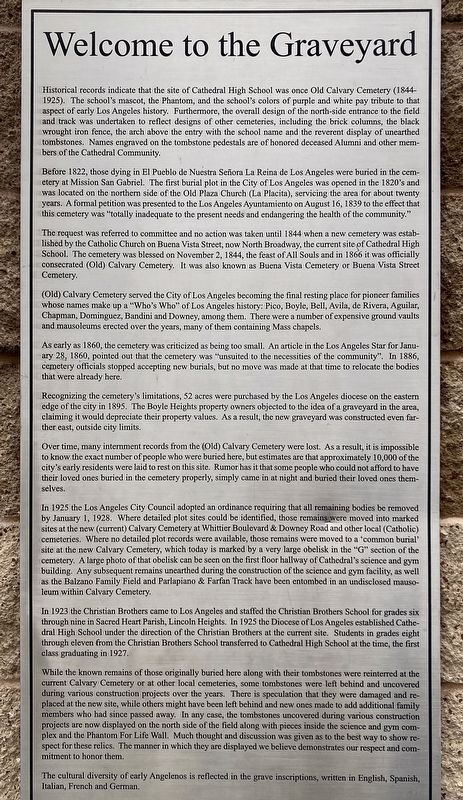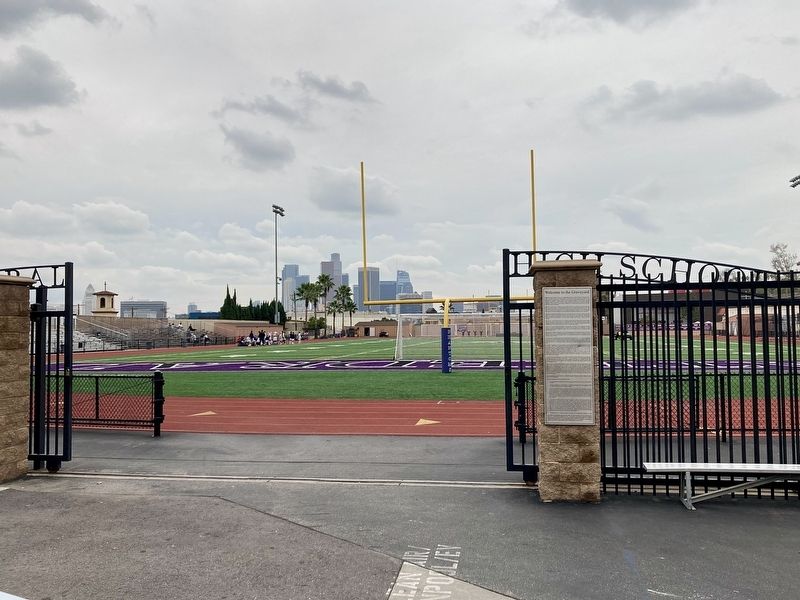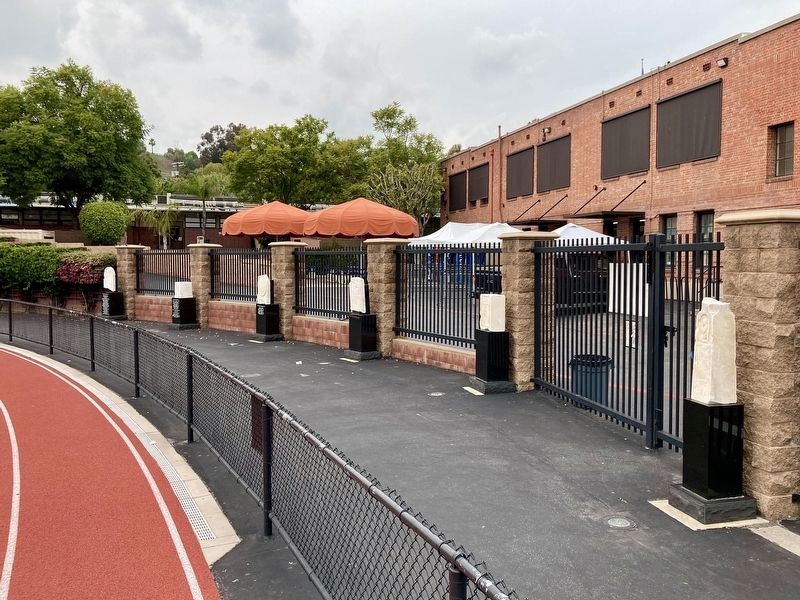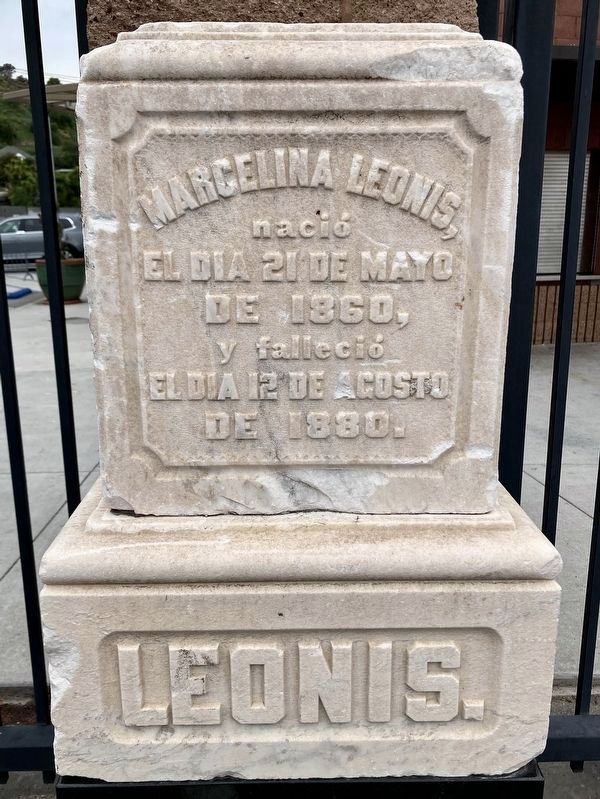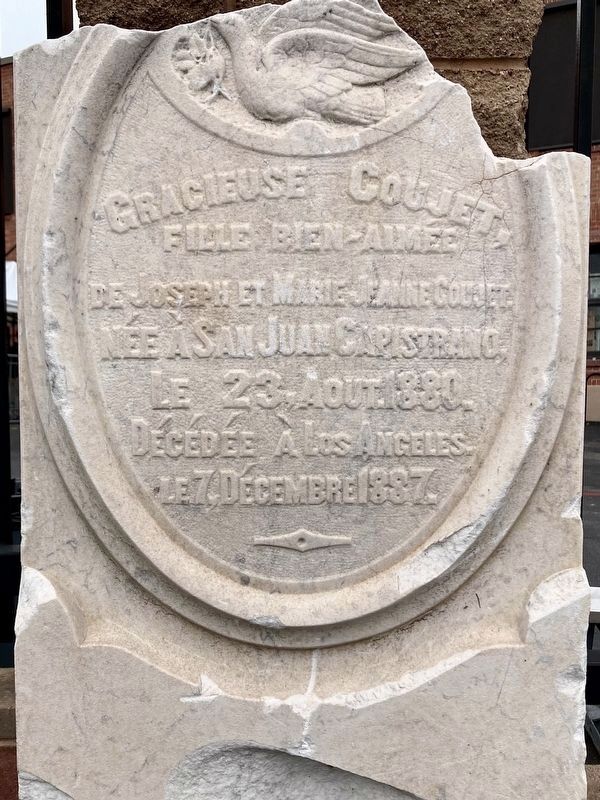Chinatown in Los Angeles in Los Angeles County, California — The American West (Pacific Coastal)
Welcome to the Graveyard
Cathedral High School
Historical records indicate that the site of Cathedral High School was once Old Calvary Cemetery (1844-1925). The school's mascot, the Phantom, and the school's colors of purple and white pay tribute to that aspect of early Los Angeles history. Furthermore, the overall design of the north-side entrance to the field and track was undertaken to reflect designs of other cemeteries, including the brick columns, the black wrought iron fence, the arch above the entry with the school name and the reverent display of unearthed tombstones. Names engraved on the tombstone pedestals are of honored deceased Alumni and other members of the Cathedral Community.
Before 1822, those dying in El Pueblo de Nuestra Señora La Reina de Los Angeles were buried in the cemetery at Mission San Gabriel. The first burial plot in the City of Los Angeles was opened in the 1820's and was located on the northern side of the Old Plaza Church (La Placita), servicing the area for about twenty years. A formal petition was presented to the Los Angeles Ayuntamiento on August 16, 1839 to the effect that this cemetery was "totally inadequate to the present needs and endangering the health of the community."
The request was referred to committee and no action was taken until 1844 when a new cemetery was established by the Catholic Church on Buena Vista Street, now North Broadway, the current site of Cathedral High School. The cemetery was blessed on November 2, 1844, the feast of All Souls and in 1866 it was officially consecrated (Old) Calvary Cemetery. It was also known as Buena Vista Cemetery or Buena Vista Street Cemetery.
(Old) Calvary Cemetery served the City of Los Angeles becoming the final resting place for pioneer families whose names make up a "Who's Who" of Los Angeles history: Pico, Boyle, Bell, Avila, de Rivera, Aguilar, Chapman, Dominguez, Bandini and Downey, among them. There were a number of expensive ground vaults and mausoleums erected over the years, many of them containing Mass chapels.
As early as 1860, the cemetery was criticized as being too small. An article in the Los Angeles Star for January 28, 1860, pointed out that the cemetery was "unsuited to the necessities of the community". In 1886, cemetery officials stopped accepting new burials, but no move was made at that time to relocate the bodies that were already here.
Recognizing the cemetery's limitations, 52 acres were purchased by the Los Angeles diocese on the eastern edge of the city in 1895. The Boyle Heights property owners objected to the idea of a graveyard in the area, claiming it would depreciate their property values. As a result, the new graveyard was constructed even farther east, outside city limits.
Over time, many internment records from the (Old) Calvary Cemetery were lost. As a result, it is impossible to know the exact number of people who were buried here, but estimates are that approximately 10,000 of the city's early residents were laid to rest on this site. Rumor has it that some people who could not afford to have their loved ones buried in the cemetery properly, simply came in at night and buried their loved ones themselves.
In 1925 the Los Angeles City Council adopted an ordinance requiring that all remaining bodies be removed by January 1, 1928. Where detailed plot sites could be identified, those remains were moved into marked sites at the new (current) Calvary Cemetery at Whittier Boulevard & Downey Road and other local (Catholic) cemeteries. Where no detailed plot records were available, those remains were moved to a 'common burial' site at the new Calvary Cemetery, which today is marked by a very large obelisk in the "G" section of the cemetery. A large photo of that obelisk can be seen on the first floor hallway of Cathedral's science and gym building. Any subsequent remains unearthed during the construction of the science and gym facility, as well as the Balzano Family Field and Parlapiano & Farfan Track have been entombed in an undisclosed mausoleum within Calvary Cemetery.
In 1923 the Christian Brothers came to Los Angeles and staffed the Christian Brothers School for grades six through nine in Sacred Heart Parish, Lincoln Heights. In 1925 the Diocese of Los Angeles established Cathedral High School under the direction of the Christian Brothers at the current site. Students in grades eight through eleven from the Christian Brothers School transferred to Cathedral High School at the time, the first class graduating in 1927.
While the known remains of those originally buried here along with their tombstones were reinterred at the current Calvary Cemetery or at other local cemeteries, some tombstones were left behind and uncovered during various construction projects over the years. There is speculation that they were damaged and replaced at the new site, while others might have been left behind and new ones made to add additional family members who had since passed away. In any case, the tombstones uncovered during various construction projects are now displayed on the north side of the field along with pieces inside the science and gym complex and the Phantom For Life Wall. Much thought and discussion was given as to the best way to show respect for these relics. The manner in which they are displayed we believe demonstrates our respect and commitment to honor them.
The cultural diversity of early Angelenos is reflected in the grave inscriptions, written in English, Spanish, Italian, French and German.
Erected 2009 by Cathedral High School. (Marker Number 281.)
Topics and series. This historical marker is listed in these topic lists: Cemeteries & Burial Sites • Education. In addition, it is included in the Los Angeles Historic-Cultural Monument series list. A significant historical year for this entry is 1844.
Location. 34° 4.153′ N, 118° 14.056′ W. Marker is in Los Angeles, California, in Los Angeles County. It is in Chinatown. Marker can be reached from the intersection of Bishops Road and Broadway. Located on the campus of Cathedral High School, at the football stadium. Touch for map. Marker is at or near this postal address: 1253 Bishops Rd, Los Angeles CA 90012, United States of America. Touch for directions.
Other nearby markers. At least 8 other markers are within walking distance of this marker. Zanja Madre (about 500 feet away, measured in a direct line); Chinatown Heritage and Visitor Center (approx. 0.2 miles away); River Station Area (approx. ¼ mile away); West Gate (approx. 0.3 miles away); Central Plaza (approx. 0.3 miles away); Dr. Sun Yat-Sen (approx. 0.3 miles away); Bruce Lee Statue (approx. 0.3 miles away); Sun Mun Way (approx. 0.4 miles away). Touch for a list and map of all markers in Los Angeles.
Regarding Welcome to the Graveyard. Cathedral High School is Los Angeles Historic-Cultural Monument No. 281, designated in 1984. “Founded in 1923, it is the oldest Catholic high school in the Archdiocese of Los Angeles. The school was built on the site of old Calvary Cemetery, where leading families of Los Angeles were buried until relocated at the turn of the 20th century.”
Credits. This page was last revised on March 16, 2024. It was originally submitted on January 25, 2024, by Craig Baker of Sylmar, California. This page has been viewed 101 times since then. Photos: 1, 2, 3, 4, 5. submitted on January 25, 2024, by Craig Baker of Sylmar, California.
